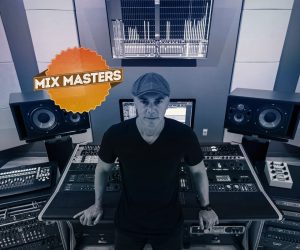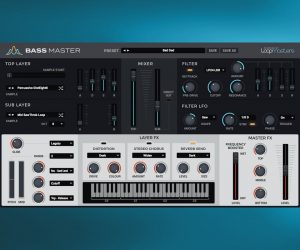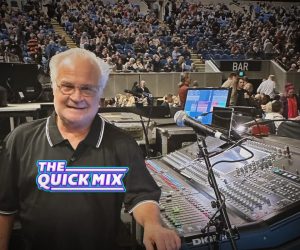
Mix Masters: Reviving The Concept Album with Neal H Pogue
In a boost to the concept album concept, Janelle Monae has released two well-received albums and an EP loosely based on Fritz Lang’s 1927 movie Metropolis. Her latest opus is The Electric Lady, which contains suites IV and V in a projected series of seven chronicling the antics of android Cindi Mayweather.

Artist: Janelle Monae
Album: The Electric Lady
The Electric Lady is a kaleidoscopic, genre-defying mash-up of different music styles and influences. Guest appearances on the album range from Prince singing and playing guitar on Givin’ Em What They Love to Solange, Miguel, and jazz bassist and singer Esparanza Spalding. Monae even goes as far as name checking Ennio Morricone, Duke Ellington, Michael Jackson and Stevie Wonder as her songwriting inspiration in the CD booklet annotations. Lead single Q.U.E.E.N. is no different, it’s a funk-pop-rock song reminiscent of Prince’s music from the ’80s, with echoes of Chic and Parliament/Funkadelic, and a guest vocal appearance from Erykah Badu.
Chuck Lightning, and brothers Roman GianArthur and Nate ‘Rocket’ Wonder have emerged as Monae’s main co-writing and production team; keeping a firm eye on the artist’s influences. Veteran mixer Neal H Pogue drew on his roots in Atlanta R&B and hip hop to wrangle those influences together.
IT ALL BEGINS ON AN SSL
Pogue always begins his mix in a commercial studio on an SSL, printing all the tracks back individually into the session as stems, and then brings the session back to his own studio for more tinkering and fine-tuning. As a result, Pogue’s final mix session for Q.U.E.E.N. contains almost 70 stereo stem tracks, most with a serving of SSL EQ and compression.
Pogue: “I’ve been an SSL guy for 25 years, and I still love to touch a board and use the SSL EQ, compression and faders. When I was in LA I used to go to a commercial studio called The Mix Room and mixed on their J-series SSL. I held out as long as I could, but began mixing in the box in 2009, largely because budgets were getting smaller, and clients were offering all-in deals, meaning they didn’t want to pay for the studio on top anymore. Also, there’s the convenience of being able to do recalls at the press of a button. It takes me a second to bring up a mix and make whatever change is wanted. This means I can offer clients unlimited recalls and don’t have to charge them for it. Finally, the sonics of working in the box have become much, much better. I still think the board sounds superior, but people have come to love the digital crunch that is part of the way people approach working in the box. They love digital distortion-to-the-point-that-it-is-shredding and the sound of the Waves L2. Many kids today don’t even know the warm sound that comes with analogue and mixing on a desk. If you’d play them a vinyl record, they’d think it sounds dark, because their ears aren’t used to it.
“I don’t do any volume rides on the SSL, the point of using it is for the summing, the SSL EQ and compression, and being able to patch in some pieces of outboard. Because I’ve worked for so many years in analogue, I also approach mixing in the box as if I am working in analogue. I often use API EQs and other plug-ins that I’m used to touching with my hands when working in analogue. I’d say that with my current approach 70% of my effects come from plug-ins and 30% from outboard.”
That said, The Electric Lady didn’t conform to the modern budget-conscious and rushed way of working. Pogue: “I was given a lot of time, like two or three days per song. Nate [Wonder], the producer, had a sound in his head, and it took time to get that right. Nate is a perfectionist and often he wanted to sit with the mix for a couple of days before making final decisions. We took an old-school approach and tried to stay away from the overly bright and compressed approaches of many of today’s mixes. We wanted to push the envelope and not be bound by 21st century mixing standards. The sound harked back to ’70s Stevie Wonder and ’80s Prince records, but also to the way the guitars sound on Red Hot Chili Peppers albums. They wanted the record to be approached in a funk, punk, and blues way. That aspect was fairly straightforward for me; because of my background I automatically and instantly knew what they needed.”


UNIVERSAL COLOUR CODE
Pogue: “One important thing I do is organise the session in my preferred way. I learned from Taavi Mote to colour code everything. The drums are in black, the bass is blue, the guitars are orange, the keyboards green, organs will be off-green, the horns are brown, the strings light blue, female lead vocals pink and male lead vocals red, and the backing vocals are purple. The sessions are also always in the same order, with the drums at the top, then bass, guitars, keys, brass, strings, lead vocals, and the backing vocals at the bottom. I use the same colours on the channel strip on the desk, and this allows me to always know immediately where everything is. My board layout is a bit unusual in that I have the vocals on channel 25 and upwards, and the drums on channel 24 going to the left. So the kick comes up under channel 24, the snare channel 23, and so on. Channels 17-24 are my drums and to the left of that are my bass, guitars and keyboards, and perhaps horns and strings on the far left. I have the drums next to the vocals because I start my mixes with the drums and this means I’m right in between the speakers for that.”
SNARING THE ACCENTS
Q.U.E.E.N. is a funk-pop-rock song reminiscent of Prince’s music from the 1980s, with echoes of Chic and Parliament/Funkadelic as well. It’s driven by a funky rhythm guitar and heavy bass, and by synthesizers popping up all over the place, which are augmented by massive backing vocals that often are made to sound like synths. One of the most striking aspects of the song is that it continually changes, with new ingredients coming in all the time — no hitting the ‘next’ button after the first verse and chorus in this case. Also, the snare only occasionally plays on 2 and 4, and is mostly used for accents, the downbeats are for the most part handled by finger snaps and hand claps. “To me the way the snare is used in this track is a breath of fresh air,” comments Pogue. “It was part of the Red Hot Chili Peppers influence, and it gave me no difficulties at all in terms of getting the groove right.
I still think the board sounds superior, but people have come to love the digital distortion-to-the-point-that-it-is-shredding and the sound of the Waves L2



SNAP & CRACKLE IN POP
Pogue: “The top drum track is an 808 kick, and after that there’s the ‘big kick,’ and then two snare tracks, ‘Fat’ and ‘Knock,’—the latter supports the former—and then a hi-hat track, which was very minimal, and natural finger snaps recorded with a binaural head, claps, three tambourine tracks, bongos and congas, three shakers and more live percussion. The only outboard I used for this entire mix was the dbx 160XT compressor and a Tube-Tech EQ on the kick. Later, when I brought the mix back to my studio, I added an API plug-in EQ on the snare ‘Knock’ track, to add some high mids and make it crack more, plus I put a Digidesign EQ on the finger snaps, to make them shine a little more.”
PRINCELY GUITARS
Pogue: “The guitars were influenced by Prince in the 1980s. Mixing this record I learned not to be afraid to do radical things EQ-wise, particularly adding high mids. Today guitars are rarely pushed to the limit, but on this record we did push them, to make them bite and stand out a bit more. So as well as using the SSL EQ, I used an API EQ to cut out some low end.”
DASHING DYNAMICS
Pogue: “The main challenge on this album was achieving the dynamics Nate and Roman were after. They wanted the songs to move and breathe, and with all the elements talking to each other. Janelle might say a line, and immediately afterwards a keyboard will come up and quickly go down again. Particularly with Q.U.E.E.N., Wonder was very specific about how even the slightest move of a synth during her vocals would make the track more exciting. The music has to sing and move right along with her. She and the music had to be one. You can see how I was riding the volume on the Moogs and Junos in particular. All the synths, horns and strings were treated only with desk EQ and compression, where necessary. Stevie Wonder’s albums from the ’70s were a major influence for the synths. I didn’t use plug-ins at all on those tracks, because everything sounded great and I didn’t want to mess with it — I wanted to keep that natural 1970s feel.”


ON A HIGH NOTE
Pogue: “Track 48 is Janelle’s lead vocal track, which has the RCompressor and the Digidesign EQ on it. It’s then sent to aux track 49 with Digidesign’s Extralong Delay for the delay throws at the end of words and lines. Track 50 is the lead vocal ad lib track, which is sent to Waves’ SuperTap delay on track 51 for a slap effect. As I said, we wanted to push the envelope with this record, and just like with the guitars we also sometimes made Janelle’s vocals sound a little harsher than usual, to create more emotion and make them cut through. EQ is so cool, you EQ something one way, and you add one kind of emotion, and you EQ it another, and you add a different emotion. Emphasising the highs and high mids can add a little bit more excitement to your record. Underneath the lead vocals are the backing vocals, which were sung by Janelle, Erykah Badu and Nate. Things can be so sterile nowadays, with the lead vocalist doing everything. I think it’s much more organic to have different vocalists sing different layers of backing vocals.”
KEEP IT DOWN
Pogue: “I mixed back into the session, which was at 24-bit/44.1k. I think going above 48k is pointless, the naked ear can’t tell the difference. I like to send the final mix through the SSL stereo bus and then EQ with either two APIs or a GML 8200, but I don’t generally use compression. I don’t like pushing my mixes to make them sound loud unless I know we’re going for a particular sound that is trying to compete with what’s out there. Nate didn’t want a particularly loud record, mostly he wanted to make sure the nostalgic element in the song shone through. For me that was very cool. Overall the idea was to have a natural sound, and that suited me, because it meant that I could focus on volume and panning in the mix, plus the occasional bit of EQ and compression. Many people reach for tons of plug-ins as if on automatic pilot, but using too many EQs destroys that natural sound. I prefer to keep it natural, and simple.”
















RESPONSES